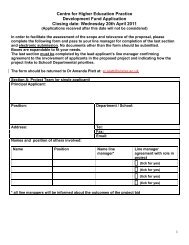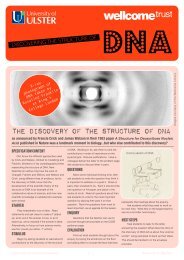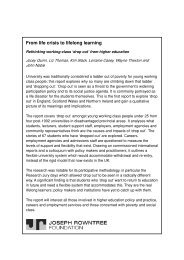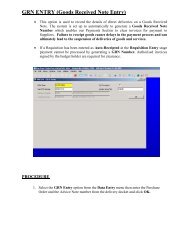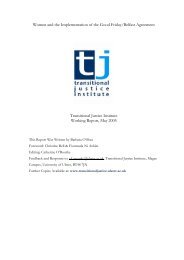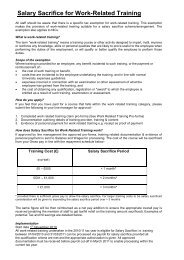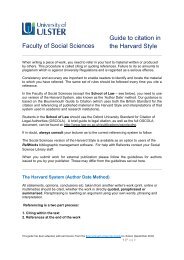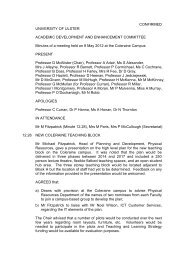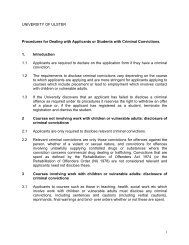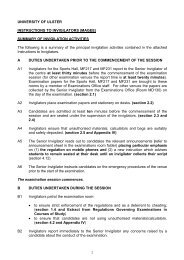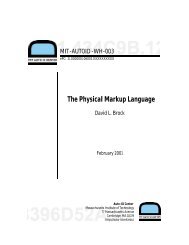The floating ball and gravity - University of Ulster
The floating ball and gravity - University of Ulster
The floating ball and gravity - University of Ulster
Create successful ePaper yourself
Turn your PDF publications into a flip-book with our unique Google optimized e-Paper software.
<strong>The</strong> oating <strong>ball</strong> <strong>and</strong><br />
GRAVITY<br />
BEATING GRAVITY WITH A PING PONG BALL<br />
Gravity is a force. It is the force that stops ever ything on earth from drifting <strong>of</strong>f<br />
into space <strong>and</strong> the force that pulls objects towards Earth. Your weight is the force<br />
<strong>of</strong> <strong>gravity</strong> that acts on you. Your weight changes with your location in the universe.<br />
OBJECTIVES<br />
To underst<strong>and</strong> the effect <strong>of</strong> forces,<br />
including <strong>gravity</strong>, on a <strong>ball</strong>.<br />
To enable children to assess their own<br />
knowledge, skills <strong>and</strong> underst<strong>and</strong>ing.<br />
STARTER<br />
Play “get in order”. Invite the whole<br />
group to st<strong>and</strong> up. Explain to the class that<br />
we are going to get into order according to<br />
date <strong>of</strong> birth. Label one side <strong>of</strong> the room as<br />
1st January <strong>and</strong> the other side as 31st<br />
December. Tell the children that there is one<br />
catch: they must do this silently. Allow 2<br />
minutes for this.<br />
Alternative criteria for ordering: height,<br />
h<strong>and</strong> size, distance from floor to belly button.<br />
Using the whole room: assign one wall<br />
to be the x axis <strong>and</strong> the wall perpendicular to<br />
be the y axis. Label the corner as 0. Ask<br />
children to plot how much fun they want to<br />
have against how much they want to learn<br />
with their body as the data point<br />
STIMULUS<br />
Why<br />
doesn’t the <strong>ball</strong><br />
fall?<br />
Demonstrate to the whole class how to<br />
hold a ping pong <strong>ball</strong> in the air with no h<strong>and</strong>s.<br />
Plug in <strong>and</strong> turn on a hair dryer in, holding it<br />
so that the nozzle is pointing upwards. Place<br />
the ping pong <strong>ball</strong> (smaller than the nozzle)<br />
into the airflow, holding the hair dryer steady<br />
so that when you let go, the ping pong <strong>ball</strong><br />
hovers in the air. Slowly change the angle <strong>of</strong><br />
the hair dryer <strong>and</strong> see how far it can be tilted<br />
before the <strong>ball</strong> falls.<br />
Extension A: Challenge one pupil at a<br />
time to see how long they can hover the ping<br />
pong <strong>ball</strong>, pass the hair dryer with ping pong<br />
to a friend, or how far they can tilt the hair<br />
dryer before the <strong>ball</strong> falls <strong>of</strong>f.<br />
Extension B: Give each child a malteser<br />
<strong>and</strong> a straw <strong>and</strong> challenge them to recreate<br />
the effect.<br />
What<br />
is the<br />
maximum<br />
angle?<br />
GENERATING QUESTIONS<br />
Allow the children time to think <strong>of</strong> a<br />
question individually. Give each pupil a post-<br />
it note (use 5 different colours, with an equal<br />
number <strong>of</strong> each colour) <strong>and</strong> ask them to<br />
record their question on the post-it. Ask the<br />
children to find others with the same colour <strong>of</strong><br />
post-it. Give the children 5 minutes in these<br />
groups to agree on one question <strong>and</strong> ask<br />
them to record it on A4 paper.<br />
SELECTING QUESTION FOR DISCUSSION<br />
What<br />
forces are<br />
involved?<br />
Collect all the A4 question sheets, read<br />
them aloud to the class <strong>and</strong> then display them<br />
in the centre <strong>of</strong> the circle. Give each pupil 3<br />
counters <strong>and</strong> explain that these counters can<br />
be used to vote however they please, for<br />
example all placed on one question or shared<br />
over 2 or 3. <strong>The</strong> question with the most votes<br />
will be the focus <strong>of</strong> the enquiry.<br />
ENQUIRY<br />
Manage turn taking by asking children to<br />
pass a cuddly toy if they want to speak.<br />
REFLECTING ON THE ENQUIRY<br />
KSU: ask the children to reflect on the<br />
knowledge they have gained, the skills they<br />
have used to gain it <strong>and</strong> what they now<br />
underst<strong>and</strong> better. Write these thoughts on<br />
an exit ticket (page 2) to be h<strong>and</strong>ed in to exit<br />
the lesson (to go to break or lunch, or just to<br />
mark the end <strong>of</strong> the enquiry lesson).<br />
Resource for Teachers 1 www.ulster.ac.uk/scienceinsociety/
Exit Ticket<br />
Knowledge I have<br />
gained<br />
Something I still want to know...<br />
Exit Ticket<br />
Knowledge I have<br />
gained<br />
Something I still want to know...<br />
Skills I have used What I underst<strong>and</strong> better<br />
Skills I have used What I underst<strong>and</strong> better<br />
Resource for Teachers 2 www.ulster.ac.uk/scienceinsociety/
forces <strong>and</strong> motion<br />
the ping pong <strong>ball</strong><br />
Ball<br />
Weight<br />
• When the hair dryer is switched <strong>of</strong>f, the<br />
<strong>ball</strong> drops to the floor. This is because<br />
the force <strong>of</strong> <strong>gravity</strong> pulls the <strong>ball</strong> towards<br />
the Earth.<br />
• When the hair dryer is switched on, the<br />
<strong>ball</strong> hovers in an invisible cylinder.<br />
• Gravity (the force due to the weight <strong>of</strong><br />
the <strong>ball</strong>) is the force that prevents the<br />
ping pong <strong>ball</strong> from flying straight up<br />
into the air (<strong>gravity</strong> pulls all objects<br />
towards earth). This is balanced by<br />
an upwards force from the hot air<br />
coming from the hair dryer.<br />
• When the angle <strong>of</strong> the hair dryer is changed slightly,<br />
the <strong>ball</strong> remains in the invisible cylinder.<br />
Upward force due<br />
to air from hair<br />
dryer<br />
Ball<br />
Weight<br />
yellow arrows show the force from the<br />
higher pressure air acting inwards on the<br />
moving air <strong>and</strong> ping pong <strong>ball</strong>.<br />
Upward force due<br />
to air from hair<br />
dryer<br />
Weight<br />
• This is because<br />
moving air is at a<br />
lower pressure than<br />
still air. <strong>The</strong> air moving<br />
around the <strong>ball</strong>, from<br />
the hair dryer, is at a<br />
lower pressure than<br />
the surrounding air.<br />
• <strong>The</strong> surrounding air<br />
therefore pushes on<br />
the moving air, holding<br />
the <strong>ball</strong> in the cylinder.<br />
This effect is called the<br />
Bernoulli effect.<br />
FORCES<br />
<strong>The</strong> Bernouilli effect can be<br />
seen with maltesers too.<br />
Resource for Teachers 3 www.ulster.ac.uk/scienceinsociety/<br />
Ball<br />
1<br />
a<br />
malteser may be<br />
“the light fantastic”<br />
but it still has<br />
weight<br />
W<br />
U<br />
W<br />
Blowing through a straw<br />
takes the place <strong>of</strong> the hair<br />
dryer. <strong>The</strong> fast moving air<br />
stream is at lower pressure<br />
than the surrounding air.



